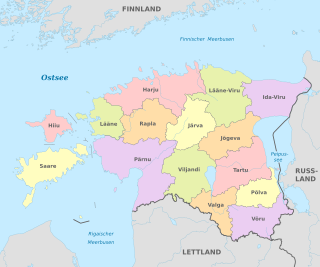The Northern Crusades or Baltic Crusades were colonization and Christianization campaigns undertaken by Catholic Christian military orders and kingdoms, primarily against the pagan Baltic, Finnic and West Slavic peoples around the southern and eastern shores of the Baltic Sea, and also against Orthodox Christian Slavs.

Viljandi County is one of 15 counties of Estonia. It is located in southern Estonia bordering Pärnu, Järva, Jõgeva, Tartu and Valga counties.

Suure-Jaani is a town in the northern part of the county of Viljandimaa in Põhja-Sakala rural municipality, 25 kilometres north of the town of Viljandi. Until 2017, Suure-Jaani was the administrative centre of Suure-Jaani rural municipality.

Counties are the state administrative subdivisions of Estonia. Estonian territory is composed of 15 counties, including 13 on the mainland and 2 on islands. County governments were abolished at the end of 2017, with their duties split between state authorities and local governments, and nowadays counties have no noteworthy independent competences. Counties are composed of municipalities of two types: urban municipalities and rural municipalities, which are by law required to cooperate in development of their county.

Saare County is one of 15 counties of Estonia. It consists of Saaremaa, the largest island of Estonia, and several smaller islands near it, most notably Muhu, Ruhnu, Abruka and Vilsandi. The county borders Lääne County to the east, Hiiu County to the north, and Latvia to the south. In 2022 Saare County had a population of 31,292, which was 2.4% of the population of Estonia.

The Livonian Chronicle of Henry is a Latin narrative of events in Livonia and surrounding areas from 1180 to 1227. It was written c. 1229 by a priest named Henry. Apart from the few references in the Primary Chronicle compiled in Kievan Rus' in the 12th century, it is the oldest known written document about the history of Estonia and Latvia.

Caupo of Turaida, or Kaupo was a leader of the Finnic-speaking Livonian people in the beginning of the 13th century, in what is now part of Latvia and Estonia. He is sometimes called a 'King of Livonia', the Chronicle of Henry of Livonia refers to him as quasi rex, 'like a king'.
The Vironians were one of the Finnic tribes that later formed the Estonian nation.

Ugandi was an independent county between the east coast of Lake Võrtsjärv and west coast of Lake Pskov, bordered by Vaiga, Mõhu, Nurmekund, Sakala, Tālava, and The Principality of Pskov. Ugandi had an area of approximately 3000 hides. Ugandi corresponded roughly to the present Estonia's territory of Võru County, Põlva County and half of Tartu County and Valga County, as well as Petseri County.

Sakala County was an ancient Estonian county that was first mentioned in print by Henry of Latvia in the early 13th century.
The Battle of Matthew's Day was fought near Viljandi on 21 September 1217 during the Livonian Crusade. The adversaries were the Sword Brethren with their recently converted Livonian and Latgalian allies versus an army of 6000 Estonian men from different counties, led by Lembitu, who had attempted to unify the Estonians. The Germans won, although the converted Livonian chieftain Caupo of Turaida died. Lembitu was also killed, and many other Estonians were forced to convert.

The Livonian crusade consists of the various military Christianisation campaigns in medieval Livonia – modern Latvia and Estonia – during the Papal-sanctioned Northern Crusades in the 12–13th century. The Livonian crusade was conducted mostly by the Holy Roman Empire and the Kingdom of Denmark. It ended with the creation of Terra Mariana and the Danish duchy of Estonia. The lands on the eastern shores of the Baltic Sea were one of the last parts of Europe to be Christianised.

Virumaa is a former independent county in Ancient Estonia. Now it is divided into Ida-Viru County or Eastern Vironia and Lääne-Viru County or Western Vironia. Vironians built many strongholds, like Tarwanpe and Agelinde.

Nurmekund was a small independent country on the north coast of Lake Võrtsjärv in Central Estonia, bordered by Sakala, Alempois, Järvamaa, Mõhu, and Ugandi. Nurmekund had an area of approximately 600 hides.

Mõtsa Pūol or Metsepole was an ancient Livonian county inhabited by the Finnic Livonians, on the east coast of the Gulf of Riga, at the northwest of what is now the Vidzeme region of Latvia. Metsepole was bordered by the ancient Estonian Sakala County to the north, Latgalian Tālava to the east and Livonian county of Turaida to the south.
Navesti is a village in Põhja-Sakala Parish, Viljandi County in central Estonia. It is located on the road between the towns of Võhma and Suure-Jaani, about 6 km from each, where the road crosses the Navesti River. Navesti village has a population of 98 and an area of 12.54 km².
The Battle of Lehola was fought in 1215 between the Livonian Brothers of the Sword, a crusading military order, and the Estonians.
Lembit is an Estonian masculine given name. A variant is Lembitu. It sometimes also may be a surname. Lembit may refer to:

Villem Kapp was an Estonian composer, organist and music teacher.










